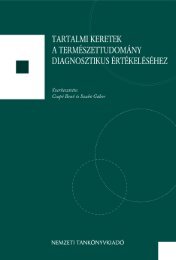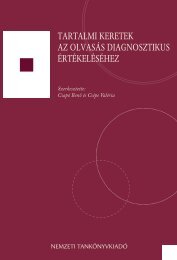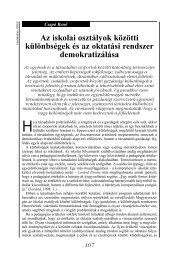értekezés - Neveléstudományi Intézet - Szegedi Tudományegyetem
értekezés - Neveléstudományi Intézet - Szegedi Tudományegyetem
értekezés - Neveléstudományi Intézet - Szegedi Tudományegyetem
You also want an ePaper? Increase the reach of your titles
YUMPU automatically turns print PDFs into web optimized ePapers that Google loves.
Hannon, E. E. és Trehub, S. E. (2005): Tuning into musical rhythms: Infants learn more<br />
readily than adults. Proceedings of the National Academy of Sciences of the USA, 102. 35.<br />
sz. 12639–12643.<br />
Hansen, D. és Bernstorf, E. (2002): Linking music learning to reading instruction. Music<br />
Educators Journal, 88. 5. sz. 17–23.<br />
Hanson, M. (2003): Effect of Kodály literacy-based music instruction the spatial reasoning<br />
skills of kindergarden students. Research and Issues of Music Education, 1. 1. sz. 1–14.<br />
Hanstra, F. H. (1994): Effects of Art Education on Visual-Spatial and Aesthetic Perception:<br />
Two Meta-Analyses. Groningen Rijksuniversiteit, Groningen.<br />
Hargreaves, D. J. (1986): The developmental psychology of music. Scope and aims. In:<br />
Spruce, G. (szerk.): Teaching Music. Routledge, London. 45–57.<br />
Hargreaves, D. J. (1996): The development of artistic and musical competence. In: Deliege, I.<br />
és Sloboda, J. (szerk.): Musical Beginnings. Oxford University Press, Oxford. 145–170.<br />
Hámori József (2005): Az emberi agy plaszticitása. Magyar Tudomány, 50. 1. sz. 43–51.<br />
Hébert, S. és Cuddy, L. L. (2006): Music-reading deficiencis and the brain. Advances in<br />
Cognitive Psychology, 2. 2–3. sz. 199–206.<br />
Hetland, L. és Winner, E. (2004): Cognitiv transfer from arts education. In: Eisner, E. és Day,<br />
M. (szerk.): Handbook on Research and Policy in Art Education. National Art Education<br />
Association. 1–67.<br />
Helmholtz, H. L. F. (1877): Die Lehre von den Tonempfindungen, als physiologische<br />
Grundlage für die Theorie der Music. 4. veränd. Auslage, Braunschweig.<br />
Herrmann, N. (1981): The creative brain. Training and Development Journal, 35. 10. sz. 10–<br />
16.<br />
Hevner, K. (1934): Oregon Music Discrimination Test. University of Oregon Publication,<br />
Oregon.<br />
Hickey, D. T. és Pellegrino, J. W. (2005): Theory, level and function: Three dimensions for<br />
understanding transfer and student assessment. In: Mestre, J. P. (szerk): Transfer of<br />
Learning: From a Modern Multidisciplinary Perspective. CT: Information Age Publishing,<br />
Greenwich. 251–312.<br />
Hildebrand, E. K. (1923): Sight Singing Test. World Book Company, New York.<br />
Ho, Y., Cheung, M. és Chan, A. S. (2003): Music training improves verbal but not visual<br />
memory: Cross-sectional and longitudinal explorations in children. Neuropsychology, 17.<br />
3. sz. 439–450.<br />
Hodges, D. A.. és O’Connell, D. S. (2005): The impact of music education on academic<br />
achievement. In: Sounds of Learning Status Report, Ch. 2. http://www.uncg.edu/<br />
mus/soundsoflearning.html<br />
Hovánszki Jánosné (2008): Indulj el egy úton… Az óvodai zenei nevelés egyik aspektusa. In:<br />
Hovánszki Jánosné (szerk.): Zenei nevelés az óvodában. Szöveggyőjtemény. Didakt Kiadó,<br />
Debrecen. 111–115.<br />
Hovánszki Jánosné (2008): A gyermekfolklór kutatás hatása az óvodai nevelésre. In:<br />
Hovánszki Jánosné (szerk.): Zenei nevelés az óvodában. Szöveggyőjtemény. Didakt Kiadó,<br />
Debrecen. 125–138.<br />
Hurwitz, I., Wolf, P. H., Bortnick, B. D. és Kokas, K. (1975): Nonmusicol effects of the<br />
Kodaly music curriculum in primary grade children. Journal of Reading Disabilities. 8. 3.<br />
sz. 167–174.<br />
287



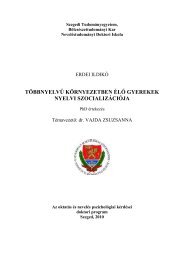

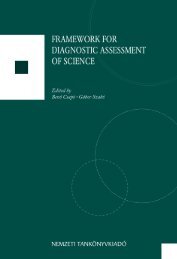
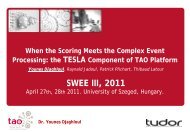
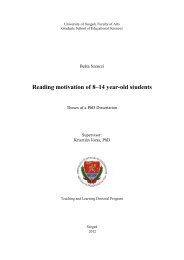

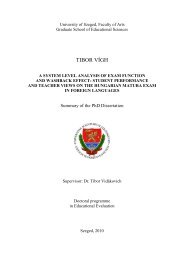
![Download [PDF] - Diagnosztikus Mérések Fejlesztése](https://img.yumpu.com/38928685/1/177x260/download-pdf-diagnosztikus-macracsek-fejlesztacse.jpg?quality=85)
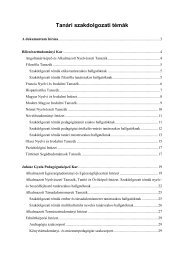


![Download [PDF] - Diagnosztikus Mérések Fejlesztése](https://img.yumpu.com/38928622/1/180x260/download-pdf-diagnosztikus-macracsek-fejlesztacse.jpg?quality=85)
